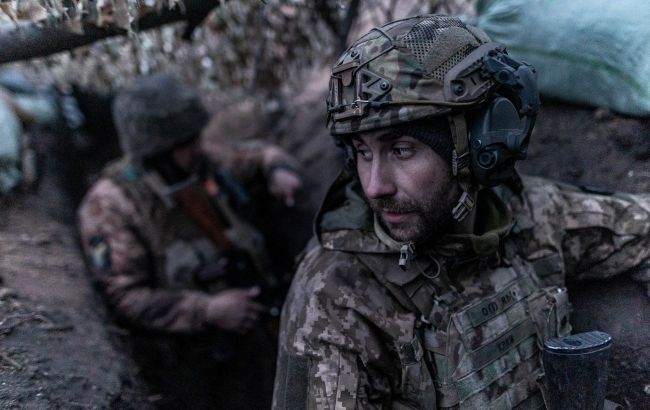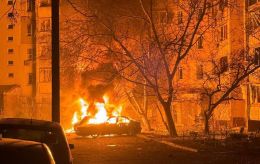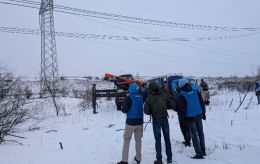Logistics for Donbas: Why Russia is targeting Kupiansk and can Ukraine hold city?
 Ukrainian troops in Kupiansk (Photo: Getty Images)
Ukrainian troops in Kupiansk (Photo: Getty Images)
In recent weeks, the situation in the Kupiansk direction has worsened. How Russian troops are trying to enter the city and what the Ukrainian Armed Forces are doing to stop them is covered in the material by RBC-Ukraine.
Russian troops continue to exert pressure along the front line. Recently, the situation has become more complicated in the Kupiansk direction in the Kharkiv region. The Russian forces are trying to enter the city through underground pipes. They are regularly eliminated, and the pipes are shelled, but the Russian soldiers do not stop attempting to capture Kupiansk.
In addition, the enemy takes advantage of the fact that there are still people remaining in the city, from time to time carrying out sabotage operations, and breaking through with small groups of soldiers. Kupiansk itself suffers from regular shelling, so the humanitarian situation is critical, and evacuating people from there is very difficult.
Second time to Kupiansk
"Two weeks ago, my insider who is there said, 'Vlad, two days and we will lose the settlement.' Two weeks have passed since then – we have not lost it," military expert Vladyslav Seleznov told RBC-Ukraine.
In 2022, Kupiansk was captured, but soon the Armed Forces of Ukraine managed to de-occupy it, and according to the military, with minimal destruction. While the city was under enemy occupation, it served as a large logistics hub, but after liberating the city, Ukrainian troops cut Russian logistics for a long time. Accordingly, for the Russian troops, capturing the city became a matter of principle in two aspects – political and military-strategic.
The Russian military-political leadership set the task of occupying the left bank of Kupiansk and Kupiansk-Vuzlovyi by November 1, 2024. The enemy lost a large amount of equipment and manpower in attempts to capture the city, but did not achieve results. One of the natural obstacles, the Oskil River, prevented the enemy from carrying out their plans.
In 2024, Russian troops managed to cross it from the left to the right bank in the area of Lyman Pershyi. When the Russian forces crossed the river, they stretched cables, tied them to trees on the right bank, and submerged them in the water.
"After that, a group of 2–4 Russian soldiers, using rafts, boats, inflatable tires from large trucks, began to cross to the right bank and carry out strike assault actions in the area of the settlement of Novomlynsk," noted Yurii Fedorenko, commander of the 429th separate regiment of unmanned systems Achilles, in a comment to RBC-Ukraine.
At that time, Russian troops managed to capture Novomlynsk, but not for long. The Defense Forces of Ukraine, in particular the Achilles regiment and the 10th separate mountain assault brigade Edelweiss, pushed the Russians back. But the enemy realized that the tactic was effective, so after some time, they decided to repeat and improve it.
Through the pipes
In recent weeks, the situation in the Kupiansk direction has worsened – Russian troops are trying to build up their forces on the northern outskirts near Kupiansk. Enemy troops are moving along the Oskil River, having captured the villages of Radkivka and Holubivka to the northwest of the city.
One of Russia’s objectives is to cross the Oskil and gain a foothold on the right bank to prepare a bridgehead for an assault on Kupiansk. For this, the enemy is using small infantry groups. According to Deep State, Russian military command has deployed the forces of the 27th Separate Motor Rifle Brigade and the 122nd Motor Rifle Regiment, which occupied the village of Lyman Pershyi, in this direction.
"They first cross the Oskil, and then get into Kupiansk through the northern suburbs. We actively destroy them, but as we see, not all of them. Some of them managed to reach the settlement, hide in basements and houses, and this is a problem," notes Seleznov.
The specifics of the eastern regions of Ukraine, lying along the border with Russia, are a branched network of shared railways, highways, and underground communications. For some time, the Russian troops continued to swim across the Oskil, but out of 10 soldiers, at most three swam to the other bank. When the Russian forces advanced to Holubivka, one of the underground pipes fell under their control.

Ukrainian artillerymen in Kupiansk (photo: Getty Images)
Soon, the number of Russian soldiers crossing the river decreased, but the intensity of fighting on the right bank only increased. Ukrainian forces understood that the Russians were moving through a pipe buried several meters beneath the riverbed, using carts (a board with wheels) and scooters for movement.
"When this became clear, fire damage was inflicted on the river, precisely in the area of the pipe. As a result, there is every reason to believe that the pipe was damaged, since enemy movement is no longer detected. Accordingly, because this happened under the water cover, the pipe may be partially flooded, but we keep it under control because the enemy will try to pump the water out," Fedorenko added.
The entrances to the pipeline are located in the area of Lyman Pershyi, where the 122nd Motor Rifle Regiment has secured a foothold. It takes about four days to walk from the village to Kupiansk, after which the Russians enter a forested area where they are difficult to detect.
Military personnel note that there are four pipelines in the Kupiansk area — three of them have already been damaged and flooded, and the exit of the fourth is under fire control by the Ukrainian Armed Forces as of 17 September.
However, on the same day, Fedorenko reported that the Ukrainian Armed Forces managed to blow up a gas pipeline through which the Russian soldiers could gather as close to the city as possible. Because of this, the enemy had to return to attempts to cross the Oskil — Ukrainian drones recorded the enemy moving along the river on rafts and boats.
Attempts to use pipes for covert movement from one point to another are not a new tactic. Using this method, the Russian troops managed to capture Avdiivka and carry out a number of successful offensive actions in the Kursk region. However, the cost of such operations is quite high.
"Pipes themselves are very toxic inside. If we are talking about a gas pipeline, some technical fluids are applied inside; the Russians themselves, in their investigations, complain that all those who walked through this gas trunk pipeline in the Kursk region later suffered lung burns and various serious illnesses — so everything is very serious," Narozhnyy notes.
Both military personnel and experts emphasize that local administrations must ensure the pipes are dug up to prevent the enemy from restoring them. This would reduce their ability to move to zero.
"We have already gone through this more than once; we have already stepped on the same rakes. Why couldn’t the local housing office and the relevant institutions that take care of the operation of sewage collectors and gas pipelines have pulled together the necessary information to prepare the city for effective defense? In particular, by mining certain directions and routes? Some issues require a response," Seleznov added.

Ukrainian soldier in front of a burned-out building in Kupiansk (photo: Getty Images)
Despite the difficulties, Ukrainian forces are managing to track the movement of Russians through the pipes and strike at the places where they exit. The pipes are also being flooded and blocked, slowing down the enemy. Therefore, it is still too early to say that the enemy has managed to enter and secure a foothold in Kupiansk. Although Russian propaganda has captured the city more than once, its claims are regularly refuted.
The latest such disinformation spread through the media space on 17 September — pro-Russian Telegram channels claimed that fighting was taking place in the center of Kupiansk. Ukrainian forces immediately denied this report, noting that the Russian soldiers continue attempts to gain a foothold in the northern part of the city.
"Information about combat in the city center does not correspond to reality. The occupiers are operating in the northern part of Kupiansk, where they managed to infiltrate from the areas of Radkivka and Holubivka. They are being destroyed, and some have been taken prisoner," said Colonel Oleksii Bielskyi, spokesperson for the Dnipro Operational-Strategic Grouping of Troops, in a comment to RBC-Ukraine.
According to Bielskyi, captured Russian soldiers said they infiltrated Kupiansk in groups of 2 to 9. Some of them disguised themselves in civilian clothing. Each group was assigned specific tasks, such as securing positions in apartment buildings.
"Additionally, the occupiers were tasked with killing all civilian men aged 18 to 60, and using women and children as human shields if necessary. Currently, an operation is ongoing to block and eliminate the occupiers who infiltrated Kupiansk," Bielskyi noted.
Russian troops have repeatedly disguised themselves in civilian clothing to blend in with locals and secure positions in the city. Their task is to monitor logistics and the movements of Ukrainian forces. They also conduct so-called actions.
"Disguised in civilian clothes, the enemy tries to reach some important location in the city, such as the central square or another recognizable square, unfurl a rag called the Russian flag, their drones take a picture, and this appears in the information space as if the Russians have taken control of Kupiansk," Fedorenko added.
Ukrainian forces have also recorded cases when Russians, in attempts to penetrate deeper into the city and gather intelligence, disguised themselves in Ukrainian uniforms. However, they were quickly identified.
The role of capturing Kupiansk
Kupiansk is part of the so-called Kupiansk urban agglomeration, but in the broader regional division, it belongs to the Kharkiv macro-agglomeration, where Kupiansk itself is considered a satellite city of Kharkiv. Since Kharkiv is quite far away, Russian troops are setting other objectives.
The city is important to the enemy mainly because it opens the way to Kupiansk-Vuzlovyi. This is a major railway junction, and Russia needs it to establish logistics and supply its troops in Donbas. After all, Kupiansk-Vuzlovyi connects Donbas with Russia’s Belgorod region.
In addition, they need to establish a link with their group of forces in the Lyman direction. Capturing Kupiansk would play an important role for them in further assault operations, both in the Lyman and Kramatorsk directions.
"Capturing Kupiansk would severely worsen our logistics and greatly improve theirs. The entire war is about logistics. They will cut our routes and improve their own. Kupiansk is located at the rear of our defenders. It is far from Kharkiv, but the capture of the city poses a greater threat to the defenders of Donbas — the Sloviansk and Kramatorsk agglomerations," Pavlo Narozhnyy noted.
In addition, capturing Kupiansk would be the kind of victory that could be presented as one of the results of the summer offensive. Since Russian forces failed to achieve any large-scale successes over the summer, Kupiansk could become one of them, especially with the help of propaganda.
The military notes that the situation near Kupiansk today is difficult but under control. So far, Russia has not managed to build up its forces and gain a foothold in the northern areas of the city, but Russian military leadership continues to send hundreds of soldiers to this area, sticking to the tactic of a "creeping offensive."

